Review of MEMS Based Fourier Transform Spectrometers
Abstract
1. Introduction
2. Theoretical Background of Fourier Transform Spectrometers
2.1. Fourier Transform Spectroscopy and Its Applications
2.2. Working Principles
2.2.1. Michelson Interferometer-Based FTS
2.2.2. Lamellar Grating Interferometer-Based FTS
3. Fourier Transform Spectrometers Based on MEMS Mirrors
3.1. Electrostatic MEMS Based FTS
3.1.1. In-Plane Electrostatic MEMS Micromirrors and FTS
3.1.2. Out-of-Plane Electrostatic MEMS Micromirrors and FTS
3.1.3. Summary
3.2. Electromagnetic MEMS Based FTS
3.2.1. Lorentz-Type Electromagnetic MEMS Micromirrors and FTS
3.2.2. Magnetic Pole-Type Electromagnetic MEMS Micromirors and FTS
3.2.3. Summary
3.3. Electrothermal Actuation MEMS Based FTS
3.3.1. In-Plane Electrothermal MEMS Micromirror and FTS
3.3.2. Out-of-Plane Electrothermal MEMS Micromirror and FTS
3.3.3. Summary
3.4. Summary of Electrostatic, Electromagnetic, and Electrothermal Actuators for MEMS FTS
4. Conclusions
Author Contributions
Funding
Conflicts of Interest
References
- Ferhanoglu, O.; Seren, H.; Lüttjohann, S.; Urey, H. Lamellar grating optimization for miniaturized fourier transform spectrometers. Opt. Express 2009, 17, 21289–21301. [Google Scholar] [CrossRef]
- Fellgett, P.I. les principes généraux des méthodes nouvelles en spectroscopie interférentielle—A propos de la théorie du spectromètre interférentiel multiplex. J. Phys. 1958, 19, 187–191. [Google Scholar] [CrossRef]
- Jacquinot, P. New developments in interference spectroscopy. Rep. Prog. Phys. 1960, 23, 267–312. [Google Scholar] [CrossRef]
- Griffiths, P.R.; James, A.D.H. Signal-to-noise ration. In Fourier transform infrared spectrometry, 2nd ed.; Wiley: Hoboken, NJ, USA, 2007; pp. 161–175. [Google Scholar]
- Xie, H.; Lan, S.; Wang, D.; Wang, W.; Sun, J.; Liu, H.; Cheng, J.; Ding, J.; Qin, Z.; Chen, Q.; et al. Miniature fourier transform spectrometers based on electrothermal MEMS mirrors with large piston scan range. In Proceedings of the 2015 IEEE SENSORS, Busan, Korea, 1–4 November 2015; pp. 1–4. [Google Scholar]
- Ayerden, N.P.; Aygun, U.; Holmstrom, S.T.S.; Olcer, S.; Can, B.; Stehle, J.-L.; Urey, H. High-speed broadband FTIR system using MEMS. Appl. Opt. 2014, 53, 7267–7272. [Google Scholar] [CrossRef]
- Manzardo, O.; Herzig, H.P.; Marxer, C.R.; de Rooij, N.F. Miniaturized time-scanning Fourier transform spectrometer based on silicon technology. Opt. Lett. 1999, 24, 1705–1707. [Google Scholar] [CrossRef]
- Solf, C.; Mohr, J.; Wallrabe, U. Miniaturized LIGA Fourier transformation spectrometer. In Proceedings of the IEEE Sensors 2003 (IEEE Cat. No.03CH37498), Toronto, ON, Canada, 22–24 October 2004; pp. 773–776. [Google Scholar]
- Chai, J.; Jia, H.-Z.; Wang, D.; Liu, H.; Chen, Q.; Xie, H. A MEMS Based Fourier Transform Spectrometer and Its Scan Stability Study. ECS J. Solid State Sci. Technol. 2018, 7, Q3025–Q3031. [Google Scholar] [CrossRef]
- Chen, Y.; Zou, C.; Mastalerz, M.; Hu, S.; Gasaway, C.; Tao, X. Applications of Micro-Fourier Transform Infrared Spectroscopy (FTIR) in the Geological Sciences—A Review. Int. J. Mol. Sci. 2015, 16, 30223–30250. [Google Scholar] [CrossRef]
- Crocombe, R.A. Miniature optical spectrometers: The art of the possible, part IV: New near-infrared technologies and spectrometers. Spectroscopy 2009, 23. Available online: http://www.spectroscopyonline.com/miniature-optical-spectrometers-art-possible-part-iv-new-near-infrared-technologies-and-spectrometer (accessed on 12 December 2019).
- Watari, M. Applications of near-infrared spectroscopy to process analysis using fourier transform spectrometer. Opt. Rev. 2010, 17, 317–322. [Google Scholar] [CrossRef]
- Wadsworth, W.; Dybwad, J.P. Rugged high-speed rotary imaging Fourier transform spectrometer for industrial use. In Proceedings of the Environmental and Industrial Sensing, Boston, MA, USA, 28–31 October 2001; pp. 83–88. [Google Scholar]
- Kita, D.; Miranda, B.; Favela, D.; Bono, D.; Michon, J.; Lin, H.; Gu, T.; Hu, J. High-performance and scalable on-chip digital Fourier transform spectroscopy. Nat. Commun. 2018, 9, 4405. [Google Scholar] [CrossRef] [PubMed]
- Köhler, M.H.; Schardt, M.; Rauscher, M.S.; Koch, A. Gas Measurement Using Static Fourier Transform Infrared Spectrometers. Sensors 2017, 17, 2612. [Google Scholar] [CrossRef] [PubMed]
- Griffiths, P.; Hall, G.; Cohen, M. Fourier transform infrared spectrometry. Science 1983, 222, 297–302. [Google Scholar] [CrossRef] [PubMed]
- Todd, S.; Xie, H. An Electrothermomechanical Lumped Element Model of an Electrothermal Bimorph Actuator. J. Microelectromech. Syst. 2008, 17, 213–225. [Google Scholar] [CrossRef]
- Strong, J.; Vanasse, G.A. Lamellar Grating Far-Infrared Interferomer. J. Opt. Soc. Am. 1960, 50, 113. [Google Scholar] [CrossRef]
- Manzardo, O.; Michaely, R.; Schädelin, F.; Noell, W.; Overstolz, T.; De Rooij, N.; Herzig, H.P. Miniature lamellar grating interferometer based on silicon technology. Opt. Lett. 2004, 29, 1437–1439. [Google Scholar] [CrossRef]
- Oldham, K.; Pulskamp, J.S.; Polcawich, R.G.; Dubey, M. Thin-film PZT lateral actautors with extended stroke. J. Microelectromech. Syst. 2008, 17, 890–899. [Google Scholar] [CrossRef]
- Liu, W.; Zhu, K.; Jia, K.; Liao, W.; Tang, Y.; Wang, B.; Xie, H. A tip–tilt–piston micromirror with a double S-shaped unimorph piezoelectric actuator. Sens. Actuators A Phys. 2014, 193, 121–128. [Google Scholar] [CrossRef]
- Holmstrom, S.T.S.; Baran, U.; Urey, H. MEMS Laser Scanners: A Review. J. Microelectromech. Syst. 2014, 23, 259–275. [Google Scholar] [CrossRef]
- Liu, W.; Liao, W.; Jia, K.; Zhu, Y.; Xie, H.; Wang, B.; Tang, Y. Hysteresis Property of Tip-Tilt-Piston Micromirror Based on Tilt-and-Lateral Shift-Free Piezoelectric Unimorph Actuator. Integr. Ferroelectr. 2014, 150, 14–22. [Google Scholar] [CrossRef]
- Antila, J.; Tuohiniemi, M.; Rissanen, A.; Kantojärvi, U.; Lahti, M.; Viherkanto, K.; Kaarre, M.; Malinen, J. MEMS-and MOEMS-based near-infrared spectrometers. In Encyclopedia of Analytical Chemistry; Meyers, R.A., Ed.; Wiley: New York, NY, USA, 2014; pp. 1–36. [Google Scholar]
- Van Kessel, P.; Hornbeck, L.; Meier, R.; Douglass, M. A MEMS-based projection display; Institute of Electrical and Electronics Engineers (IEEE): Piscataway, NJ, USA, 1998; Volume 86, pp. 1687–1704. [Google Scholar]
- Dudley, D.; Duncan, W.M.; Slaughter, J. Emerging digital micromirror device (DMD) applications. Micromach. Microfabr. 2003, 4985, 14–25. [Google Scholar]
- Liu, C. Foundations of MEMS, 2nd ed.; Gilfillan, A., Dworkin, A., Eds.; Prentice Hall: Upper Saddle River, NJ, USA, 2012. [Google Scholar]
- Lamminpää, A.; Holmlund, C.; Mannila, R.; Saari, H. MEMS mirror for miniaturized Fourier transform spectrometer. In Proceedings of the 6th ESA Round Table on Micro & Nano Technologies for Space Applications, Noordwijk, The Netherlands, 8 October 2007; pp. 303–312. [Google Scholar]
- Briand, D.; Manzardo, O.; De Rooij, N.F.; Hildenbrand, J.; Wollenstein, J. Gas Detection using a Micromachined FTIR Spectrometer. In Proceedings of the 2007 IEEE SENSORS, Atlanta GA, USA, 28–31 October 2007; pp. 1364–1367. [Google Scholar]
- Merenda, F.; Bühler, S.; Farah, H.; Boer, G.; Scharf, T. Portable NIR/MIR Fourier-transform spectrometer based on a common path lamellar grating interferometer. Proc. SPIE 2010, 7680. [Google Scholar] [CrossRef]
- Yu, K.; Lee, D.; Krishnamoorthy, U.; Park, N.; Solgaard, O. Micromachined Fourier transform spectrometer on silicon optical bench platform. Sensors Actuators A Phys. 2006, 130, 523–530. [Google Scholar] [CrossRef]
- Saadany, B.; Omran, H.; Medhat, M.; Marty, F.; Khalil, D.; Bourouina, T. MEMS tunable Michelson interferometer with robust beam splitting architecture. In Proceedings of the 2009 IEEE/LEOS International Conference on Optical MEMS and Nanophotonics, Clearwater, FL, USA, 17–20 August 2009; pp. 49–50. [Google Scholar]
- Khalil, D.; Sabry, Y.; Omran, H.; Medhat, M.; Hafez, A.; Saadany, B. Characterization of MEMS FTIR spectrometer. Proc. SPIE 2011, 7930. [Google Scholar] [CrossRef]
- Si-Ware Systems. SiMOSTTM. Available online: http://www.siware.com/uploads/simost_brochure.pdf (accessed on 16 May 2019).
- Mortada, B.; Sabry, Y.; Nagi, M.; Hassan, K.; Saadany, B.; Bourouina, T.; Khalil, D. High-throughput deeply-etched scanning Michelson interferometer on-chip. In Proceedings of the 2014 International Conference on Optical MEMS and Nanophotonics, Glasgow, UK, 17–21 August 2014; pp. 161–162. [Google Scholar]
- Eltagoury, Y.M.; Sabry, Y.; Khalil, D. Novel Fourier transform infrared spectrometer architecture based on cascaded Fabry-Perot interferometers. Proc. SPIE 2016, 9760, 97600. [Google Scholar]
- Sandner, T.; Kenda, A.; Drabe, C.; Schenk, H.; Scherf, W. Miniaturized FTIR-spectrometer based on optical MEMS translatory actuator. Proc. SPIE 2007, 6466, 646602. [Google Scholar]
- Sandner, T.; Graßhoff, T.; Gaumont, E.; Schenk, H.; Kenda, A. Translatory MOEMS actuator and system integration for miniaturized Fourier transform spectrometers. J. Micro/Nanolithogr. MEMS, MOEMS 2014, 13, 11115. [Google Scholar] [CrossRef]
- Ataman, C.; Urey, H.; Wolter, A. A Fourier transform spectrometer using resonant vertical comb actuators. J. Micromech. Microeng. 2006, 16, 2517–2523. [Google Scholar] [CrossRef]
- Ataman, C.; Urey, H.; Isikman, S.O.; Wolter, A. A MEMS based visible-NIR Fourier transform microspectrometer. Photonics Eur. 2006, 6186, 61860. [Google Scholar]
- Seren, H.R.; Ayerden, N.P.; Sharma, J.; Holmstrom, S.T.; Sandner, T.; Grasshoff, T.; Schenk, H.; Urey, H. Lamellar grating based MEMS Fourier Transform Spectrometer. In Proceedings of the 2010 International Conference on Optical MEMS and Nanophotonics, Sapporo, Japan, 9–12 August 2010; pp. 105–106. [Google Scholar]
- Solf, C.; Janssen, A.; Mohr, J.; Ruzzu, A.; Wallrabe, U. Incorporating design rules into the LIGA technology applied to a fourier transformation spectrometer. Microsyst. Technol. 2004, 10, 706–710. [Google Scholar] [CrossRef]
- Wallrabe, U.; Solf, C.; Mohr, J.; Korvink, J. Miniaturized Fourier Transform Spectrometer for the near infrared wavelength regime incorporating an electromagnetic linear actuator. Sensors Actuators A Phys. 2005, 123, 459–467. [Google Scholar] [CrossRef]
- Yu, H.B. An electromagnetically driven Lamellar grating based Fourier transform microspectrometer. J. Micromech. Microeng. 2008, 18, 1–6. [Google Scholar]
- Baran, U.; Hedili, K.; Olcer, S.; Urey, H. FR4 Electromagnetic Scanner Based Fourier Transform Spectrometer. In Proceedings of the Volume 2: 31st Computers and Information in Engineering Conference, Parts A and B; ASME International: New York, NY, USA, 2011; pp. 465–469. [Google Scholar]
- Xue, Y.; He, S. A translation micromirror with large quasi-static displacement and high surface quality. J. Micromech. Microeng. 2016, 27, 15009. [Google Scholar] [CrossRef]
- Cowen, A.; Dudley, B.; Hill, E.; Walters, M.; Wood, R.; Johnson, S.; Wynands, H.; Hardy, B. 2009 MetalMUMPs Design Handbook a MUMPs® Process; MEMScAP Inc.: Durham, NC, USA; pp. 1–39.
- Xue, Y.; Zuo, H.; He, S. A repulsive magnetic force driven translation micromirror. J. Micromech. Microeng. 2007, 27, 1–10. [Google Scholar] [CrossRef][Green Version]
- Sin, J.; Lee, W.H.; Popa, D.; Stephanou, H.E. Assembled Fourier transform micro-spectrometer. Proc. SPIE 2006, 6109, 610904. [Google Scholar]
- Das, A.N.; Sin, J.; Popa, D.O.; Stephanou, H.E. Design and Manufacturing of a Fourier Transform Microspectrometer. In Proceedings of the 2008 8th IEEE Conference on Nanotechnology, Arlington, TX, USA, 18–21 August 2008; pp. 837–840. [Google Scholar]
- Das, A.N.; Popa, D.; Sin, J.; Stephanou, H.E. Precision alignment and assembly of a Fourier transform microspectrometer. J. Micro-Nano Mechatron. 2009, 5, 15–28. [Google Scholar] [CrossRef]
- Reyes, D.; Schildkraut, E.R.; Kim, J.; Connors, R.F.; Kotidis, P.; Cavicchio, D.J. A novel method of creating a surface micromachined 3D optical assembly for MEMS-based miniaturized FTIR spectrometers. Proc. SPIE 2008, 6888, 68880. [Google Scholar]
- Deutsch, E.R.; Reyes, D.; Schildkraut, E.R.; Kim, J. High-resolution miniature FTIR spectrometer enabled by a large linear travel MEMS pop-up mirror. Proc. SPIE 2009, 7319, 73190. [Google Scholar]
- Sandia National Laboratories. SUMMiT-V Overview. Available online: http://mems.sandia.gov/tech-info/summit-v.html (accessed on 16 May 2019).
- Wu, L.; Xie, H. A large vertical displacement electrothermal bimorph microactuator with very small lateral shift. Sensors Actuators A Phys. 2008, 145, 371–379. [Google Scholar] [CrossRef]
- Wu, L.; Pais, A.; Samuelson, S.R.; Guo, S.; Xie, H. A Miniature Fourier Transform Spectrometer by a Large-Vertical-Displacement Microelectromechanical Mirror. In Proceedings of the Fourier Transform Spectroscopy 2009, Vancouver, BC, Canada, 26–30 April 2009. [Google Scholar]
- Wu, L.; Pais, A.; Samuelson, S.R.; Guo, S.; Xie, H. A mirror-tilt-insensitive Fourier transform spectrometer based on a large vertical displacement micromirror with dual reflective surface. In Proceedings of the TRANSDUCERS 2009—2009 International Solid-State Sensors, Actuators and Microsystems Conference, Denver, CO, USA, 21–25 June 2009; pp. 2090–2093. [Google Scholar]
- Wang, W.; Chen, J.; Zivkovic, A.S.; Xie, H. A Fourier Transform Spectrometer Based on an Electrothermal MEMS Mirror with Improved Linear Scan Range. Sensors 2016, 16, 1611. [Google Scholar] [CrossRef]
- Samuelson, S.R.; Xie, H. A large displacement MEMS mirror with electrothermal ladder actuation arrays for ultra-low tilt applications. J. Microelectromech. Syst. 2014, 23, 39–49. [Google Scholar] [CrossRef]




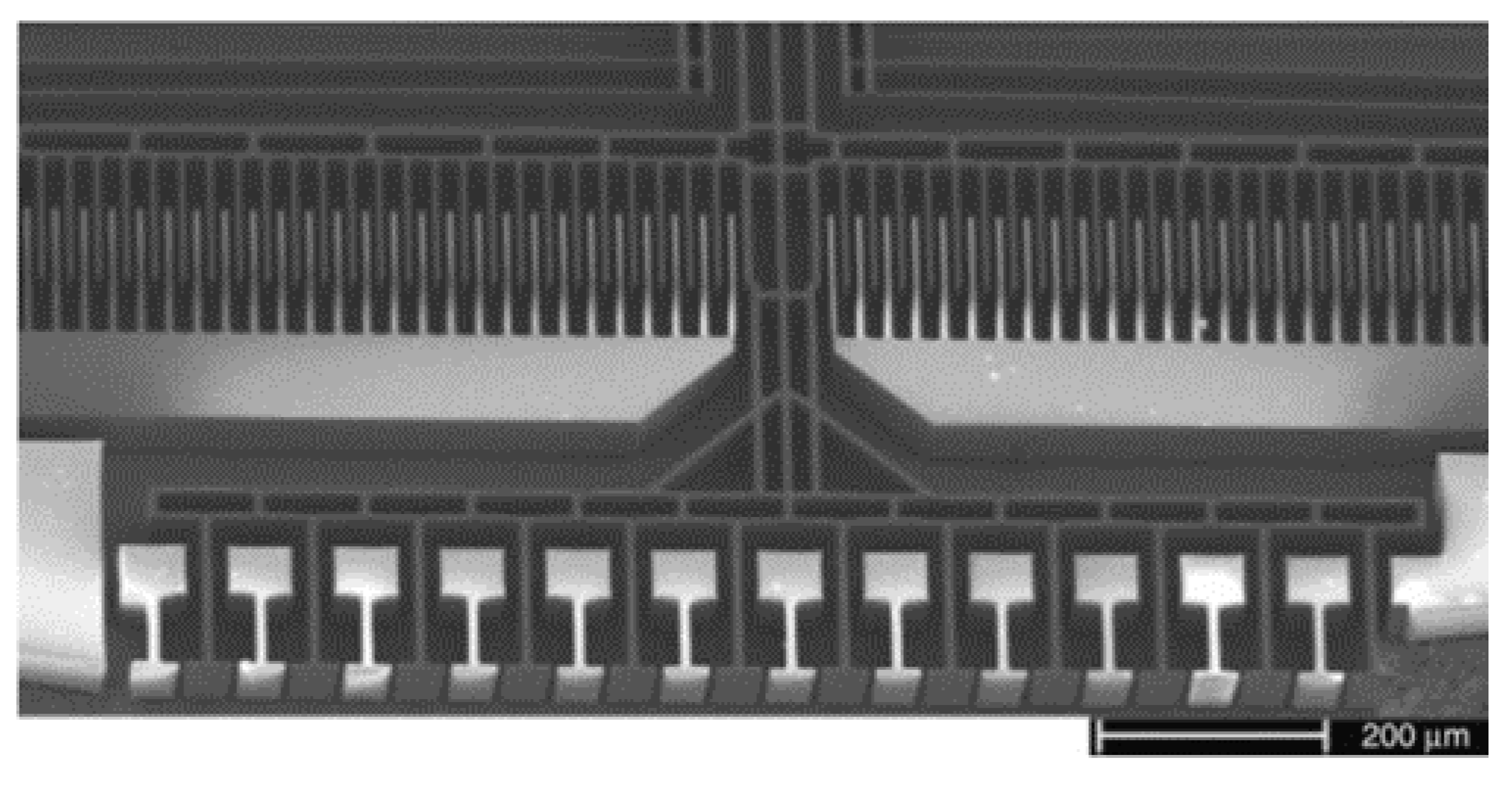
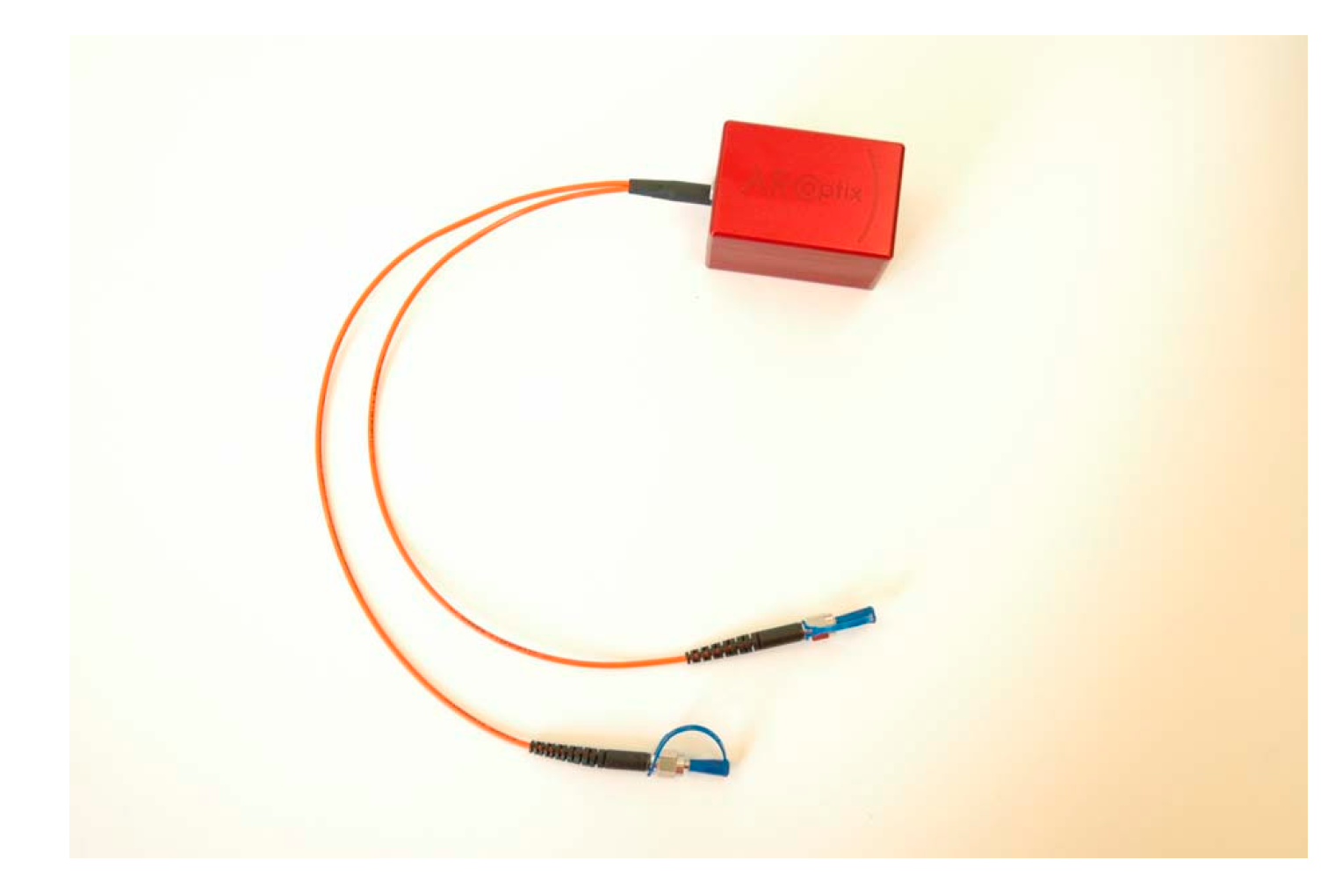
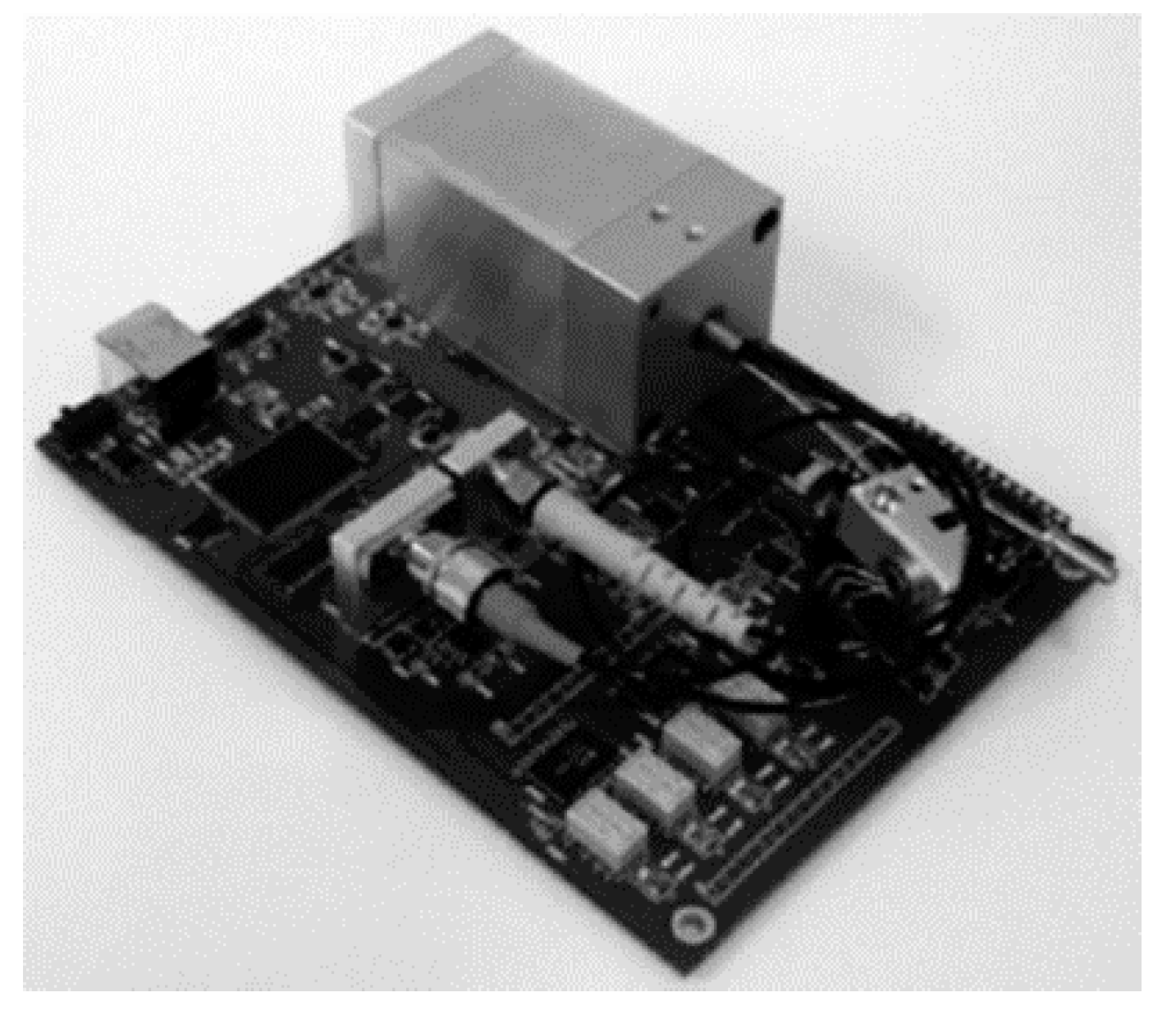
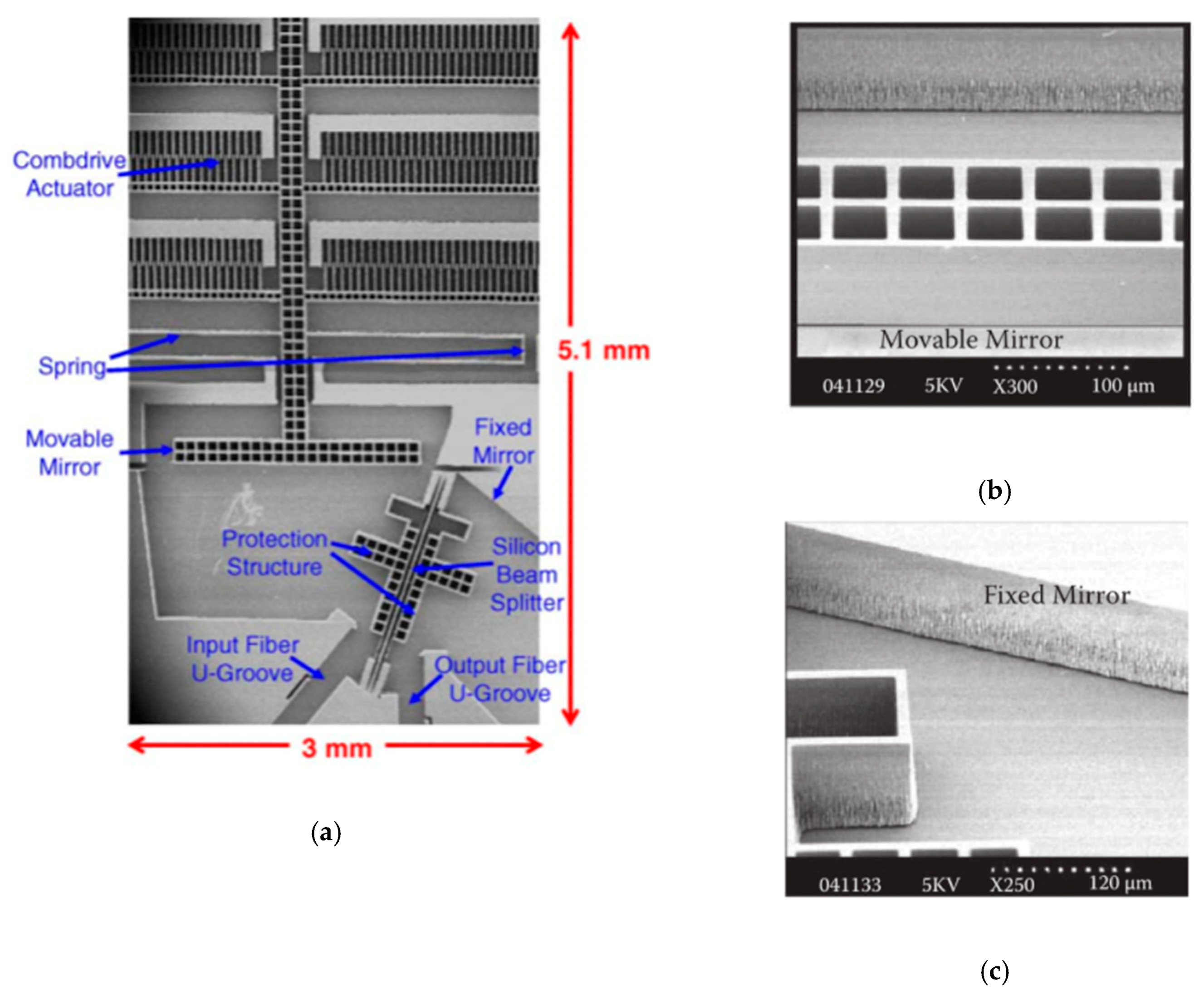


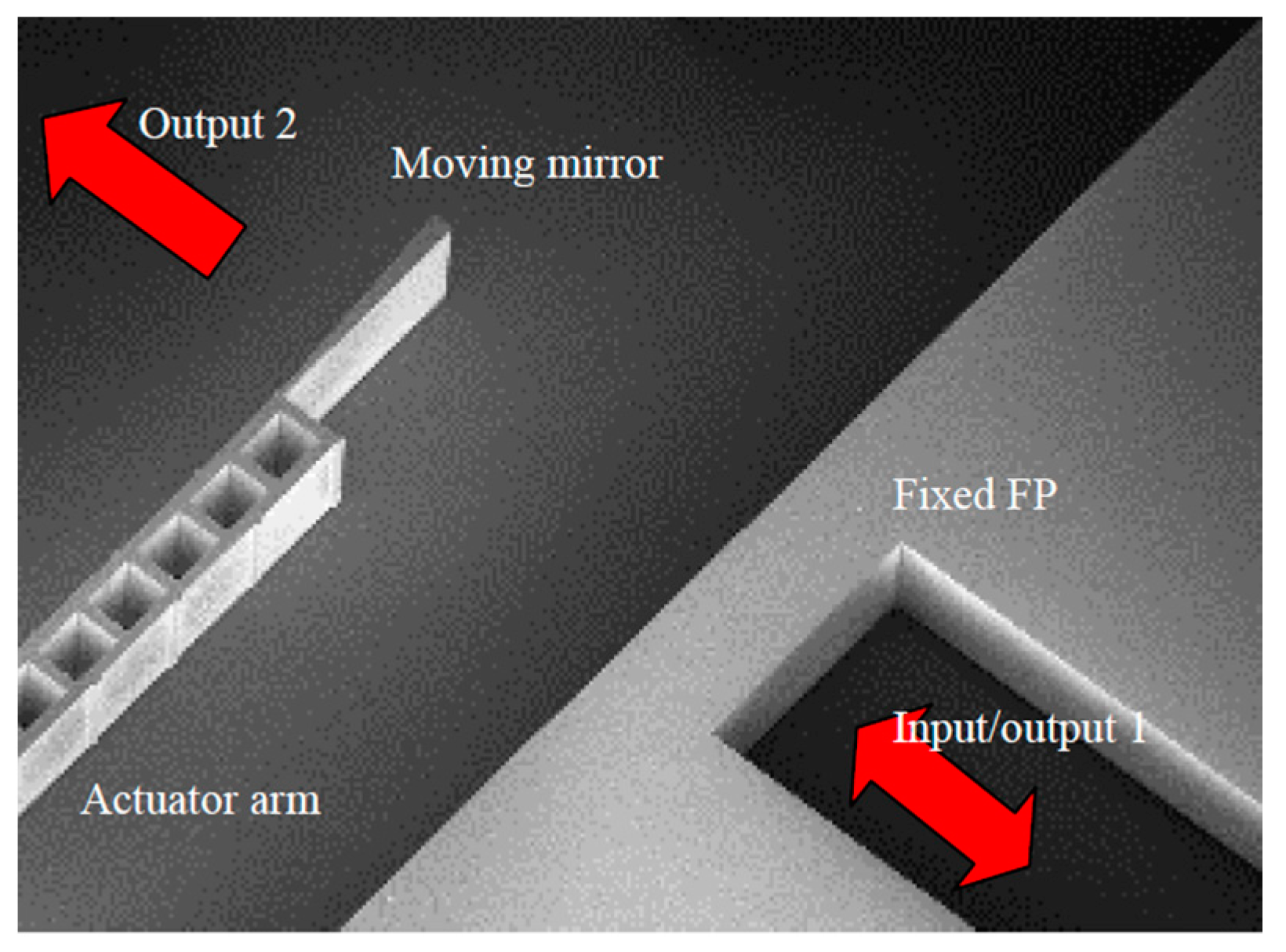

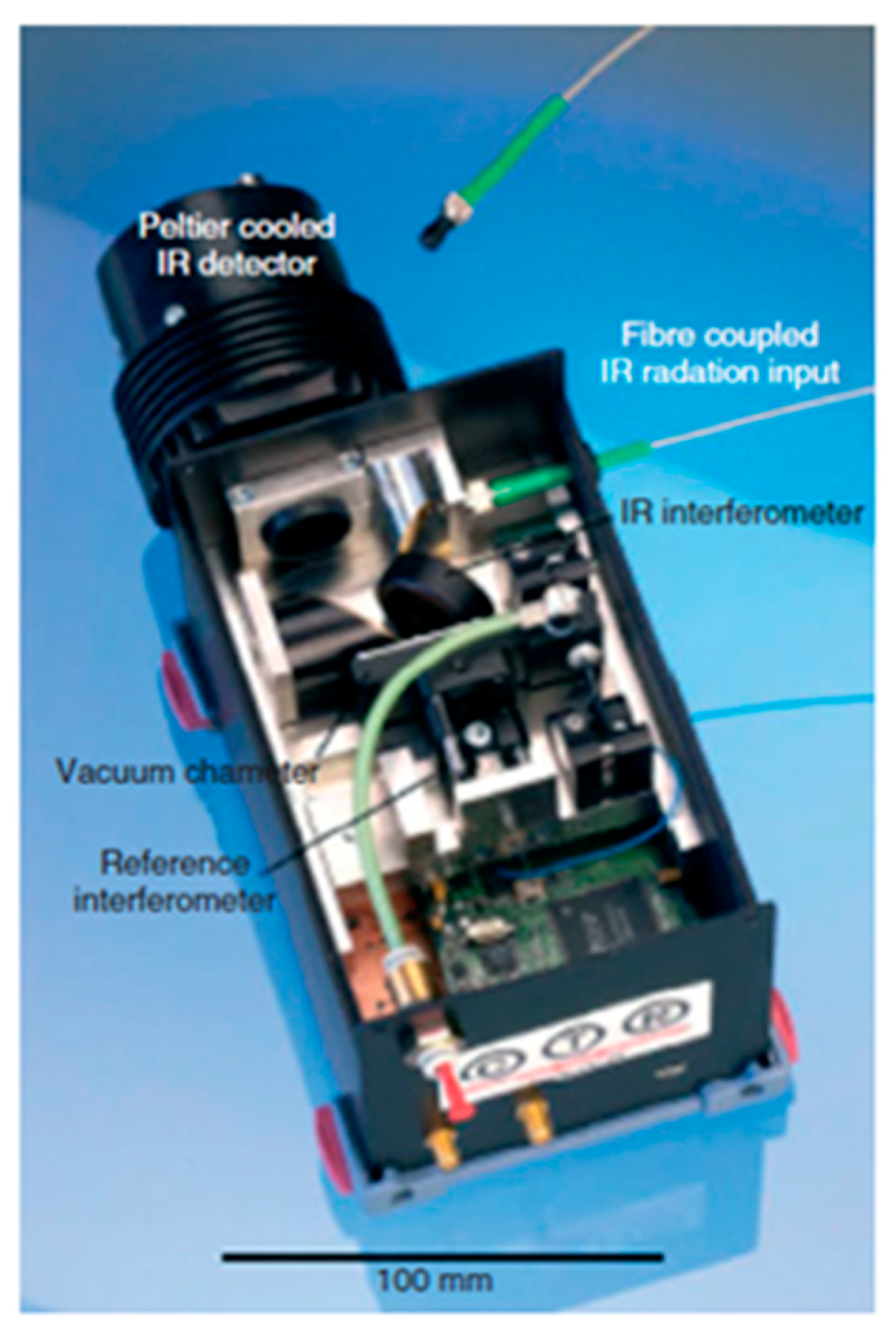
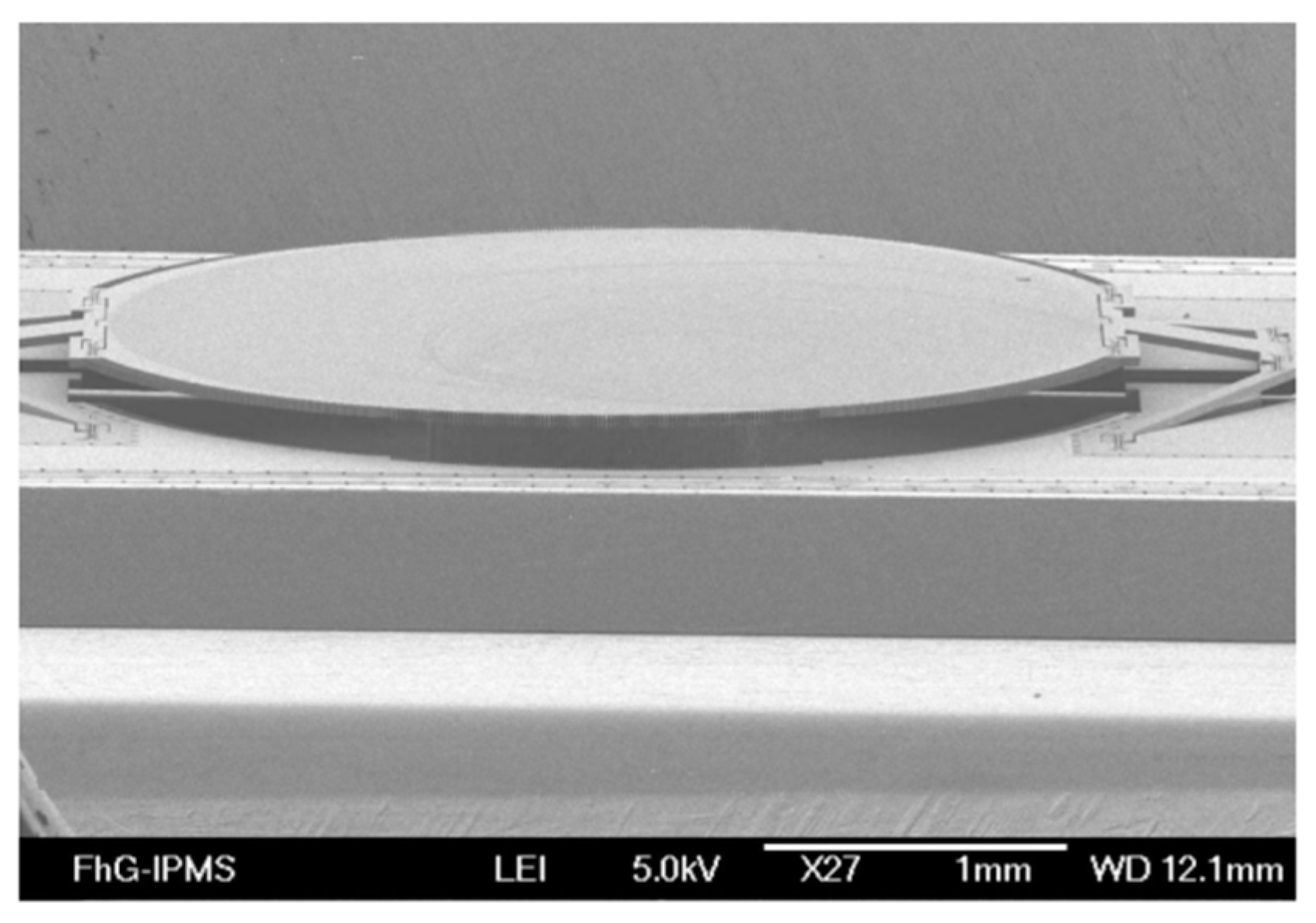


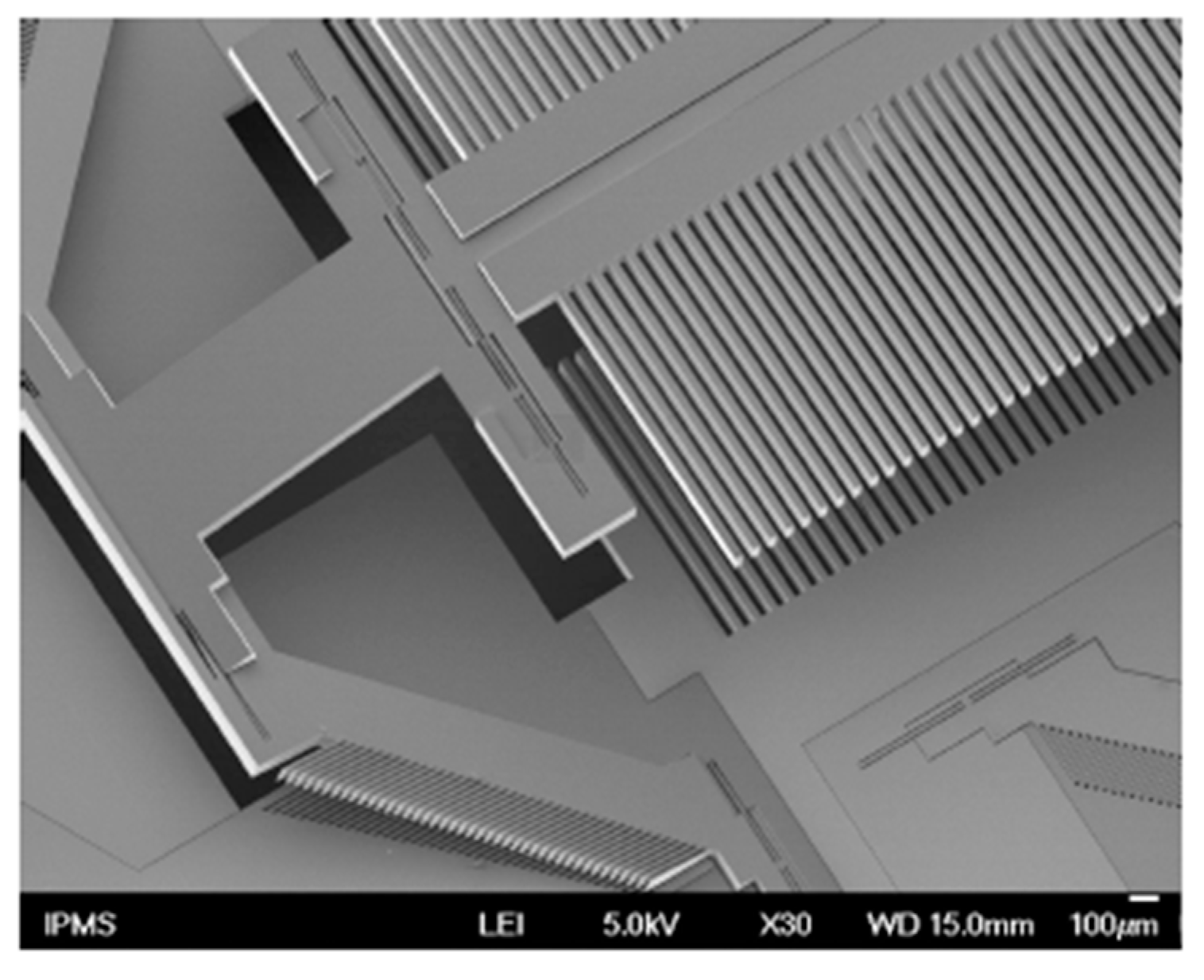


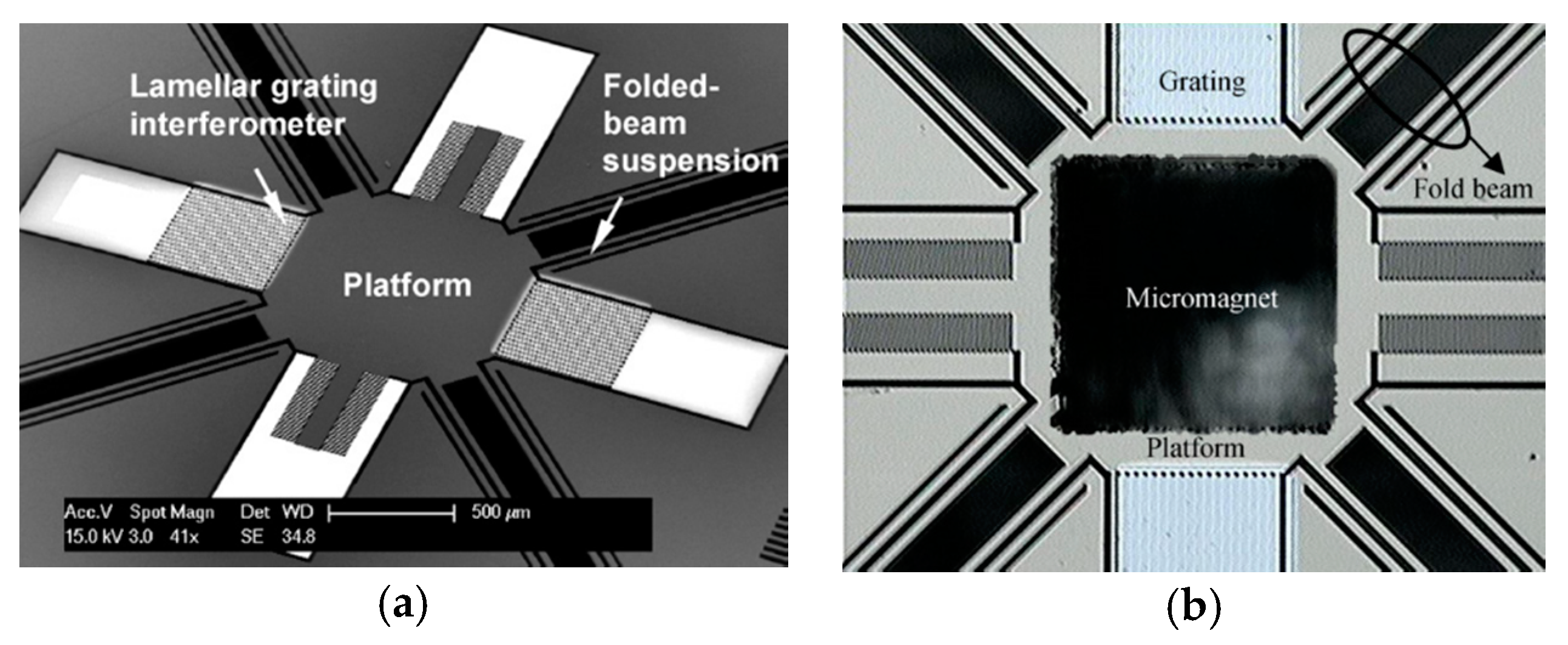

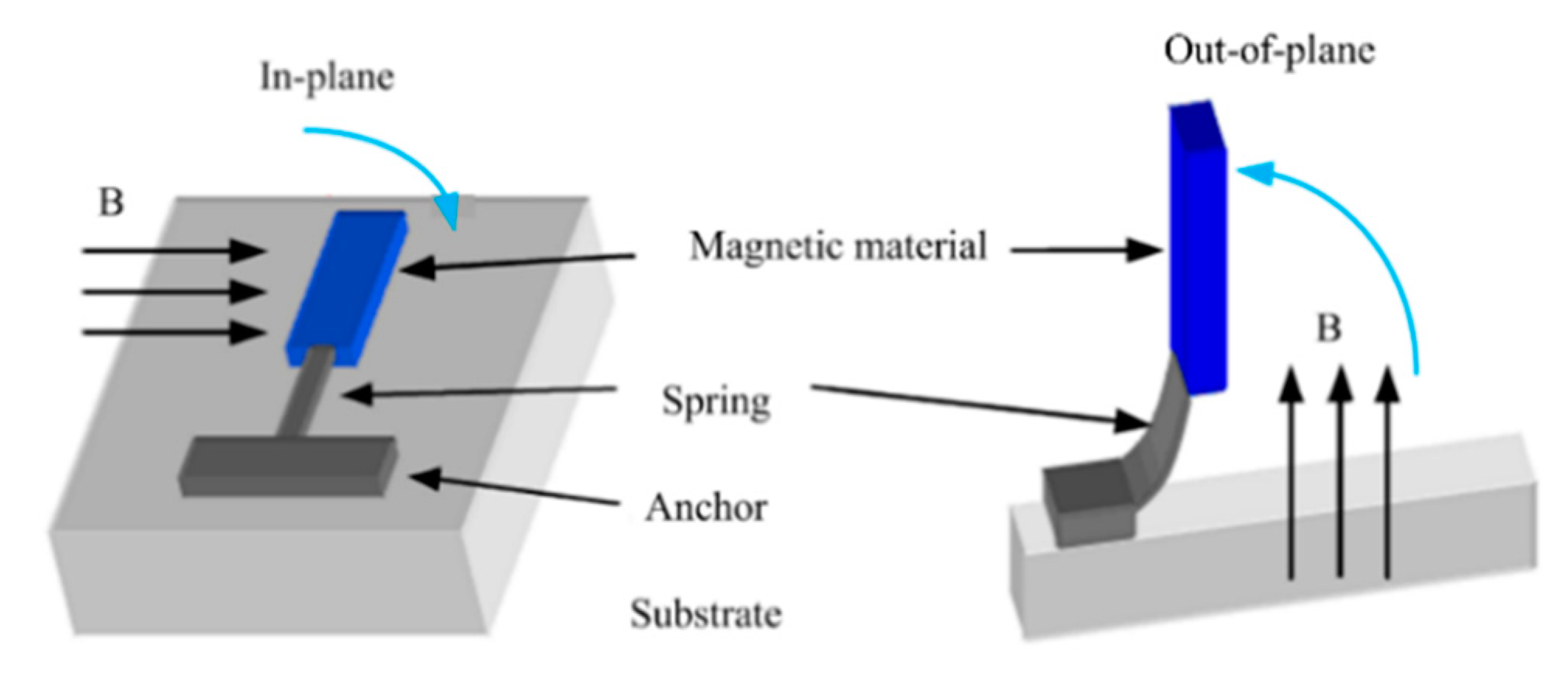
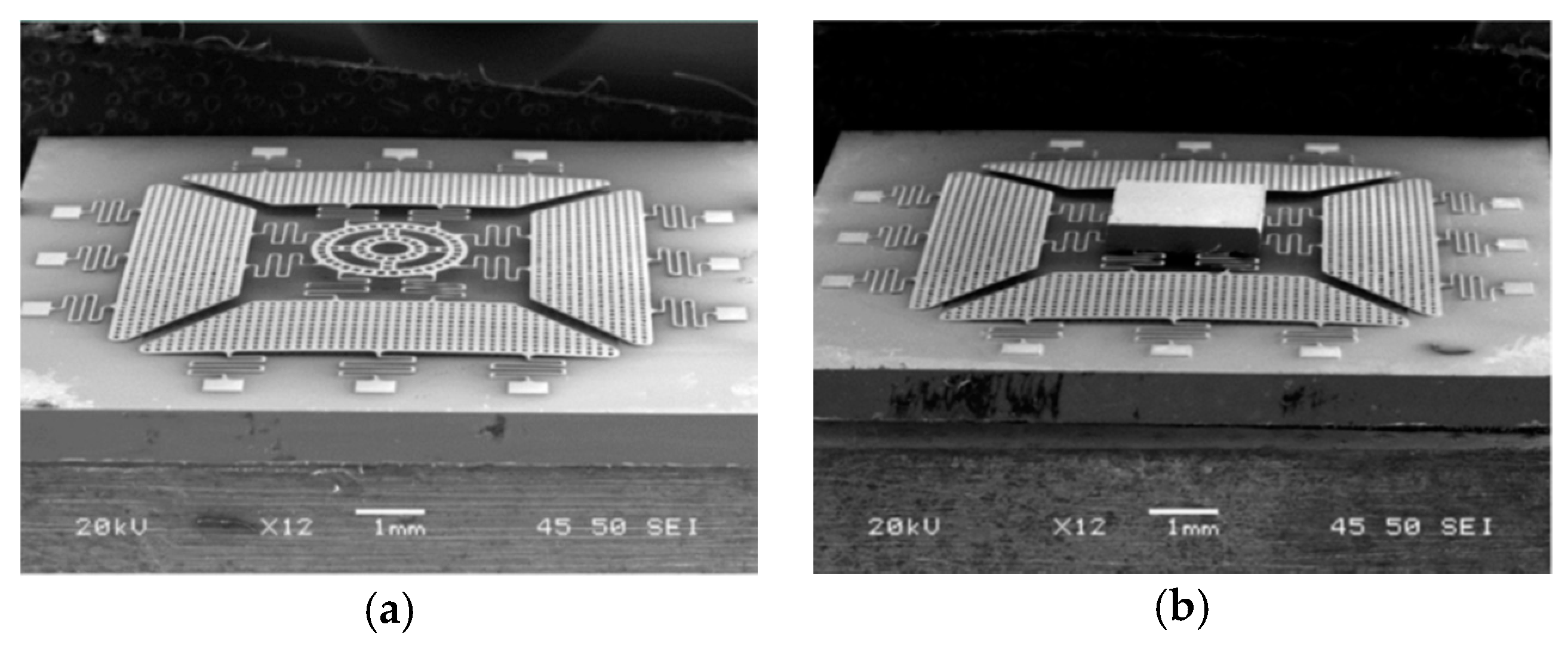

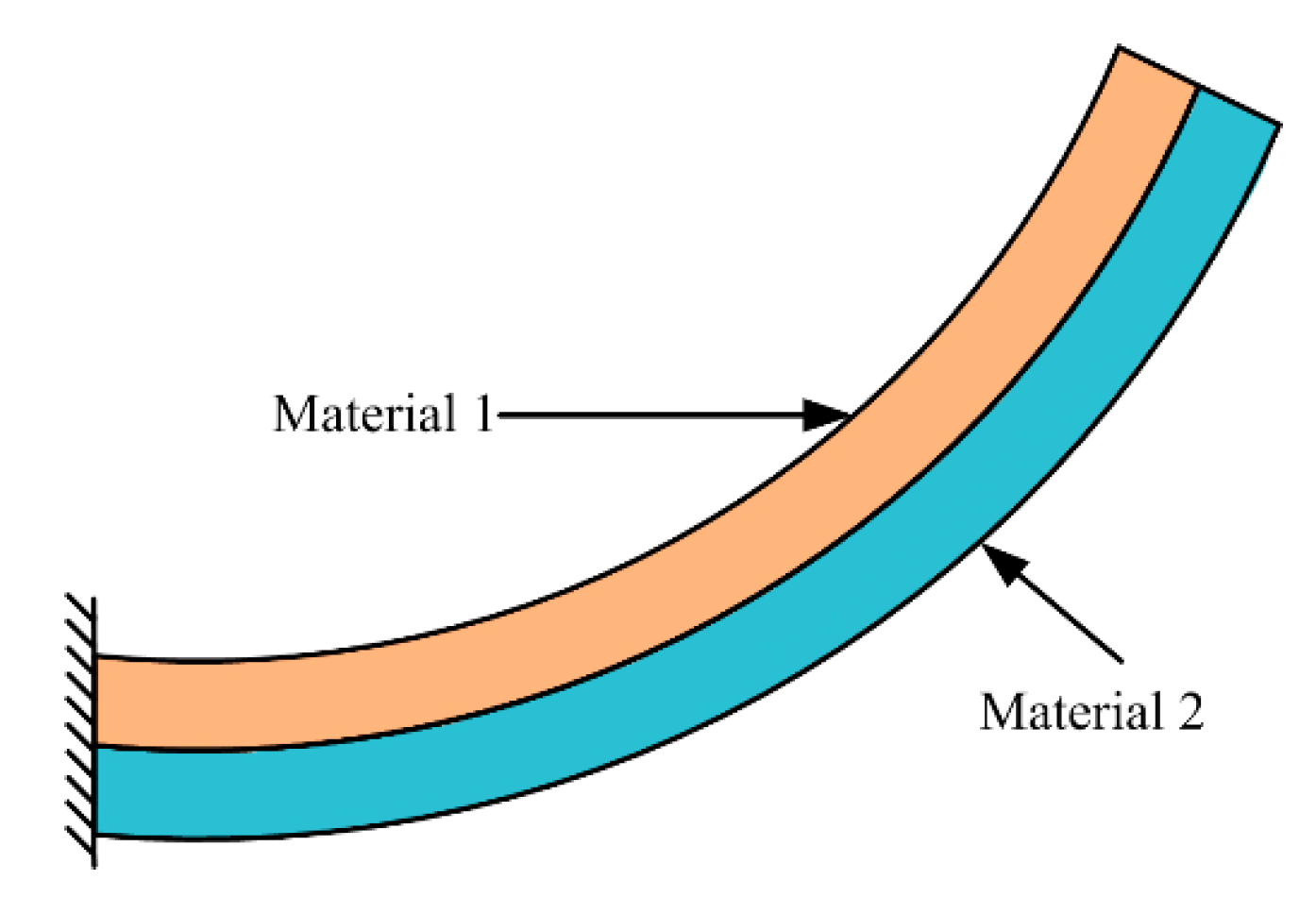





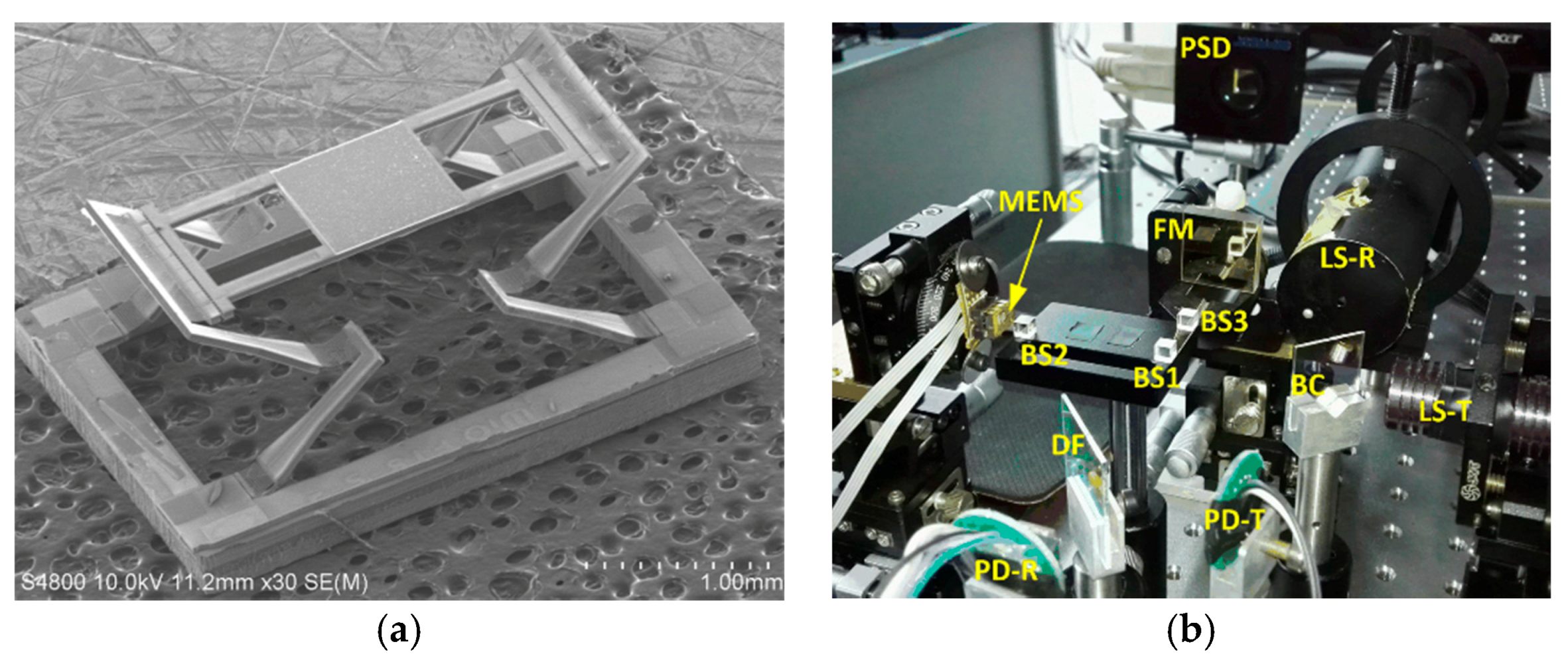
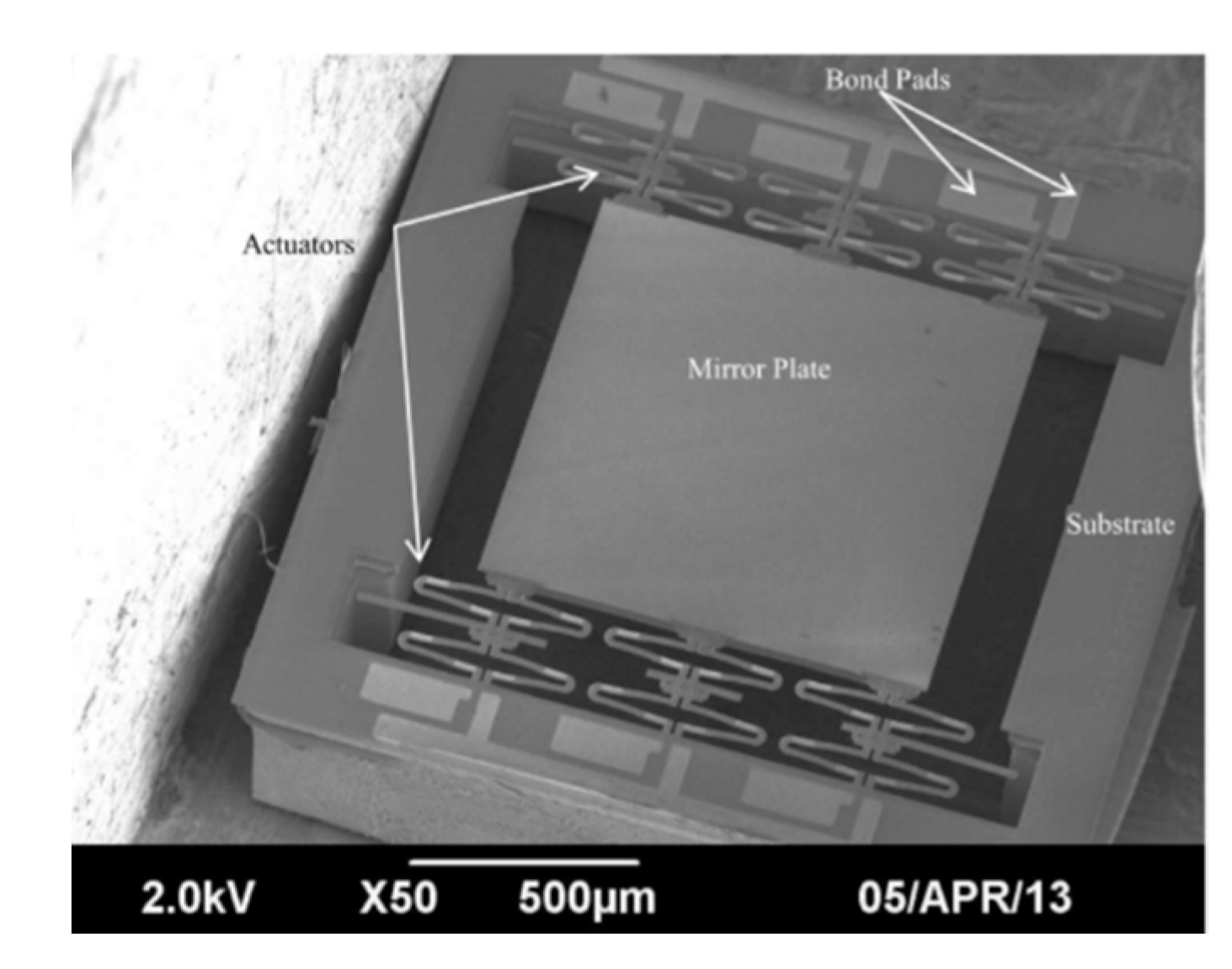

| Authors | Institution | Actuation Type | Core of FTS | Displacement | Work Condition | Device Size | Reference |
|---|---|---|---|---|---|---|---|
| Manzardo et al. | UniNE | In-plane | MI | 77 μm | 10 V–amplitude | MEMS chip: 5 × 4 mm2 (Mirror: 75 × 500 μm2) | [7] |
| Manzardo et al. | UniNE | In-plane | LGI | 145 μm | 65 V | MEMS chip: 5 × 5 mm2 | [19] |
| Merenda et al. | ARCoptix and EPFL | In-plane | LGI | >500 μm | − | Entire FTS: 10 × 15 × 7 cm3 | [30] |
| Yu et al | SNU, Stanford, and SNL | In-plane | MI | 25 μm | 150 V @ 5 Hz | Entire FTS: 4 × 8 × 0.6 mm3 | [31] |
| Khalil et al. | ASU and SWS | In-plane | MI | 48 μm | @ resonance | - | [32,33] |
| Khalil et al. | ASU and SWS | In-plane | MZI | 62.5 μm | 70 V @ resonance | Entire FTS: 1 × 2 mm2 | [33] |
| Mortada et al. | SWS, EP, and ASU | In-plane | MI | 62.5 μm or 200 μm | − | − | [35] |
| Eltagoury et al. | ASU and SWS | In-plane | FPI | − | − | − | [36] |
| Sandner et al. | IPMS | Out-of-plane | − | 200 μm | 40 V @ 100 Pa vacuum, 5 kHz | MEMS chip: 1.8 × 9 mm2 (Mirror: 1.5 × 1.1 mm2) | [37] |
| Sandner et al. | IPMS | Out-of-plane | − | 500 μm | 500 Hz | Aperture: 3 mm in diameter | [37] |
| Sandner et al. | IPMS | Out-of-plane | − | 1.2 mm | 50 V @ 30 Pa vacuum, 500 Hz | Aperture: 5 mm in diameter | [38] |
| Ataman et al. | KU and IPMS | Out-of-plane | LGI | 106 μm | 28 V @ resonance | Aperture: 3 × 3 mm2 | [39,40] |
| Seren et al. | KU and IPMS | Out-of-plane | LGI | 355 μm | 76 V @ 971 Hz | Aperture: 10 × 10 mm2 | [41] |
| Authors | Institution | Actuation Type | Core of FTS | Displacement | Work Condition | Device Size | Reference |
|---|---|---|---|---|---|---|---|
| Wallrabe et al. | Uni Freiburg and FK | Lorentz-type | MI | 110 μm | 12 mW | Entire FTS: 11.5 × 9.4 mm2 | [8,43] |
| Yu et al. | NUS and DSI | Lorentz-type | LGI | 125 μm | 129 mA–amplitude | − | [44] |
| Baran et al. | KU | Lorentz-type | MI | 325.6 μm | 120 mVpp @ 149 Hz | MEMS chip: 7 × 8 cm2 (Mirror: 1 × 1 cm2) | [45] |
| Xue et al. | RU | Magnetic pole-type | − | 123 μm | 400 mA. | Mirror: 2 × 2 mm2 | [46] |
| Xue et al. | RU | Magnetic pole-type | − | 144 μm | 140 mA | Mirror: 2 × 2 mm2 | [48] |
| Authors | Institution | Actuation Type | Core of FTS | Displacement | Work Condition | Device Size | Reference |
|---|---|---|---|---|---|---|---|
| Sin et al. | UTA | In-plane | MI | 30 μm | 22 V | Entire FTS: 10 × 10 mm2 (Mirror: 0.5 × 0.45 mm2) | [49] |
| Das et al. | UTA | In-plane | MI | 45 μm | 45 V | Entire FTS: 10 × 10 mm2 (Mirror: 1 × 0.8 mm2) | [50,51] |
| Reyes et al. | BML | In-plane | MI | 600 nm | − | − | [52,53] |
| Wu et al. | UF | Out-of-plane | − | 620 μm | 5.3 V. | − | [55] |
| Wu et al. | UF | Out-of-plane | MI | 131 μm and 308 μm | − | Entire FTS: 12 × 5 × 5 cm3 | [57] |
| Wang et al. | SJTU and UF | Out-of-plane | MI | 550 μm | 7 V DC | MEMS chip: 4.3 × 3.1 mm2 (Mirror: 1.1 × 1.1 mm2) | [58] |
| Samuelson et al. | UF | Out-of-plane | − | 90 μm | 1.2 V DC | MEMS chip: 1.9 × 1.9 mm2 (Mirror Aperture: 1mm) | [59] |
| Chai et al. | USST, WiO Tech, and UF | Out-of-plane | MI | 200 μm | 5 Vpp @ 5 Hz | MEMS chip: 3.65 × 11.4 mm2 (Mirror: 1.4 × 1.2 mm2) | [9] |
| Various Actuators | Advantages | Disadvantages |
|---|---|---|
| Electrostatic actuators | Fast response | Vacuum package and resonance operation |
| Low power consumption | Limited displacement | |
| Pull-in behavior | ||
| Electromagnetic actuators | Moderately large displacement | External magnetic field needed |
| Large size | ||
| Electrothermal actuators | Large displacement | Large power consumption |
| Moderately fast response | Sensitivity to environmental temperature changes |
© 2020 by the authors. Licensee MDPI, Basel, Switzerland. This article is an open access article distributed under the terms and conditions of the Creative Commons Attribution (CC BY) license (http://creativecommons.org/licenses/by/4.0/).
Share and Cite
Chai, J.; Zhang, K.; Xue, Y.; Liu, W.; Chen, T.; Lu, Y.; Zhao, G. Review of MEMS Based Fourier Transform Spectrometers. Micromachines 2020, 11, 214. https://doi.org/10.3390/mi11020214
Chai J, Zhang K, Xue Y, Liu W, Chen T, Lu Y, Zhao G. Review of MEMS Based Fourier Transform Spectrometers. Micromachines. 2020; 11(2):214. https://doi.org/10.3390/mi11020214
Chicago/Turabian StyleChai, Junyu, Kun Zhang, Yuan Xue, Wenguang Liu, Tian Chen, Yao Lu, and Guomin Zhao. 2020. "Review of MEMS Based Fourier Transform Spectrometers" Micromachines 11, no. 2: 214. https://doi.org/10.3390/mi11020214
APA StyleChai, J., Zhang, K., Xue, Y., Liu, W., Chen, T., Lu, Y., & Zhao, G. (2020). Review of MEMS Based Fourier Transform Spectrometers. Micromachines, 11(2), 214. https://doi.org/10.3390/mi11020214




